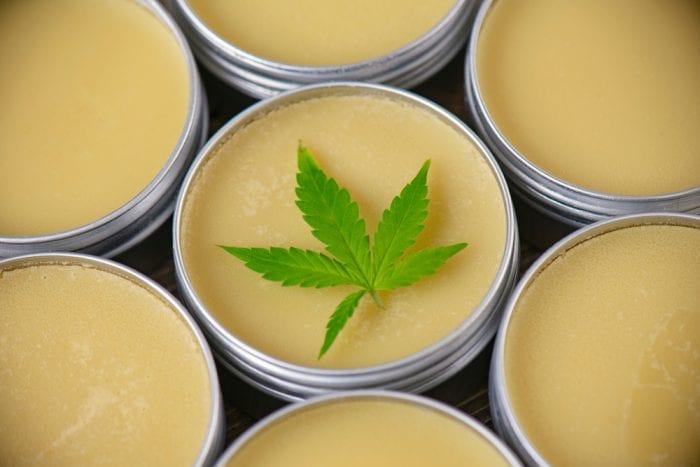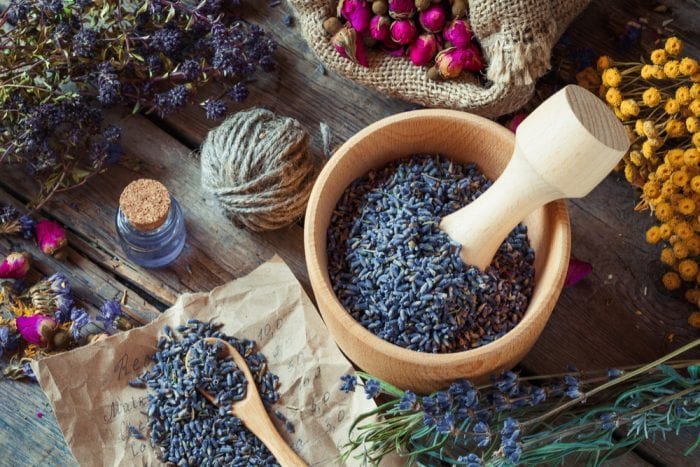Cannabis topicals are the perfect DIY project.
Practically every dispensary today carries cannabis topicals, things like lotions, balms, and salves. With so many options now available, why would someone make their own?
Patients may want to make their own cannabis topicals for a few reasons. Sensitive patients with allergies may need the assurance of certain ingredients. Other patients may rely on a particularly strain with unique qualities. Still others may discover their local shop ran out of their most trustworthy topical brand, and desperate times call for DIY measures.
Whatever the reason, making cannabis topicals is a relatively straightforward and easy process. Whether it’s a lotion, a balm, or a salve, all homemade cannabis topicals begin with a simple base. Just make sure the cannabis you use is of a decent quality and from a trusted and responsible source.

How to Make the Base Salve
You can make as much or as little salve as needed. The recipe below lists approximations so feel free to tweak the values.
- ¼ cup grated beeswax
- 1 cup coconut oil or olive oil
- ¼ oz. cannabis flower
- Baking sheet
- Saucepan and metal bowl or double boiler
- Large pot
- Mason Jar
- Cheesecloth
To make a thicker balm, try 1 cup grated beeswax for every cup of coconut oil. Beeswax also improves the shelf life of cannabis topicals.
First – Decarb the Cannabis
Before anything else, first activate the cannabinoids in the buds through decarboxylation, otherwise known as “heating.”
- Preheat oven to 120°C (250°F).
- Break up cannabis buds (do not grind). Separate any stems or seeds. (If you have seeds, complain to your supplier.)
- Place into the mason jar and tightly close the lid.
- Place the cannabis filled jar into a water bath (large pot of water) on the stove top, making sure the water does not cover the jar (3/4 up is fine)
- Bring the water to a boil then turn down to a summer for 35 min. Be very careful to monitor the water levels and add hot water as needed to prevent a dry pan.

Next – Infuse the Oil
- Add oil to the saucepan or double boiler.
- Melt the coconut oil at the lowest heat setting available, or simply keep the heat low if using olive oil.
- Add decarboxylated cannabis to the oil.
- Stir for 20 to 25 minutes on low heat.
It’s important to keep the heat low during the oil infusion steps. Too much heat will overheat the cannabis and burn off the good stuff, like cannabinoids and terpenes.
Customize Cannabis Topicals for Your Needs
You can also customize the salve by adding powdered herbs during the infusion process. Plantain, comfrey, arnica, thyme, and calendula can facilitate healing for wounds and skin conditions.
Other herbs may transform the topical’s immediate sensation properties. To create a cooling salve, try eucalyptus, peppermint, lavender, hibiscus, lemon, or rosemary. To create a warming salve, try clove, ginger, myrrh, cinnamon, black pepper, or cayenne pepper. (And be conservative if you go with the peppers… remember, we’re making salves here, not mace.)
Or try various combinations of the above.

Mix Everything Together
- Strain the oil and cannabis through a cheesecloth into a jar.
- Discard the cannabis. (Trust me, you don’t want to smoke it.)
- Add your beeswax. Optionally, add some vitamin E as a preservative.
And voila! You’re done! Let the mixture cool, and it’s ready to tackle any swelling, itching, or aching with a thin application across the skin.
As yet another option, essential oils can also be added to the topical mixture much like powdered herbs. Since essential oils are typically loaded with terpenes – which can be heat sensitive – it is best to add them as the mixture cools rather than while being heated. This will preserve the medicinal powers held within the terpenes.
Experiment, Experiment, Experiment….
Just as every cannabis patient is different, so too will this recipe differ according to personal preferences. If the salve feels too thin or oily, use less oil or more beeswax. If the salve feels too thick, use more oil or less beeswax. Different oils (avocado, arnica, St. John’s wort, etc.) may produce different consistencies, so experimentation will ultimately produce the best results.
For more advanced topical crafters, consider butters like shea butter or cocoa butter to diversify textures, enhance aromas, or perhaps just to beef up the topical’s healing properties.
Once you’ve got the topical made, be sure to check out RxLeaf’s guide on how to properly apply topicals.






dave
i decarbed this way, ONE TIME. had my landlord knocking on my door. (even in Colorado, extreme smell is cop calling business, you want to send cops to people? ). I researched into decarbing a little more and low and behold, this way, not only smells up your neighborhood. but it releases much of your medicine into the air, and away from medicating YOU. You can decarb in a sealed cooking jar. let cool and the terpenes will be re-absorbed into the bud. (terpenes a big part of the entourage system). You can decarb in your infusion method also. Most people at first, simply used a crock-pot with a water-bath in it. put in a mason jar with your bud and oil. put on high for 12 hours, (takes 4 hours to get up to temp on high 8 hours on low) . Do Not Pre-Heat water bath, will crack mason jar. I put a knee high over mouth of mason jar, flip over the container i will use to store in fridge and squeeze all the medicine out of the mix. squeeze it some more, I get infused oil. amounts? i use a half quart mason jar, 7 gm’s of broken up top shelve, 7 ounces of coconut oil. this may be shared and / or changed.
Spider L. Ryan
I just want to say that while this is probably good for people to make if they have bunches of money but, I can get a 2 oz. jar of “Red Dragon Balm/ Deep Tissue Relief” from the pot shop here in town and it only costs $14and lasts me about 1 1/2 to 2 months, where as buying a 1/4 oz. of flower will cost around $70. not to mention the coconut oil… Anyway, Just had to put that out there.